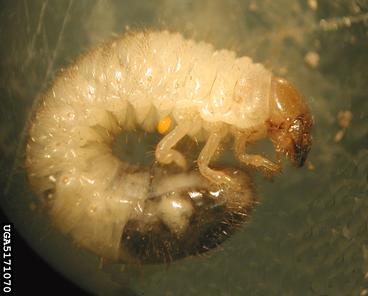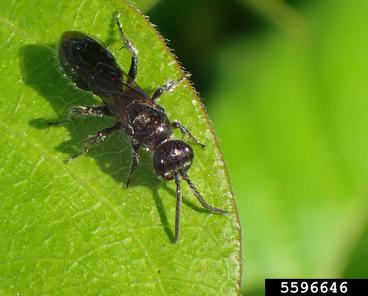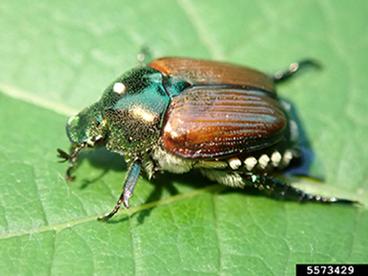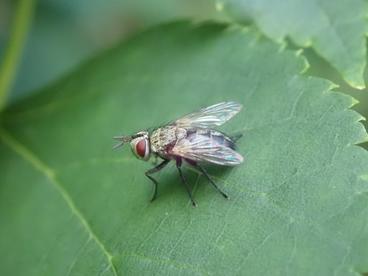The Japanese beetle (JB) is a serious pest of turf and ornamental plants. Grubs feed on the roots of grass and adults feed on the foliage of more than 300 plant species. Japanese beetles were first found in United States in 1916, after being accidentally introduced into New Jersey. Until that time, this insect was known to occur only in Japan where it is not a major pest. It is controlled in the eastern United States by soil-inhabiting protozoans that are not present in Minnesota. There are two biological control agents, the fly Istocheta aldrichi and the tiphid wasp, Tiphia vernalis, but they do not control infestations.
There are a number of related beetles in the family Scarabaeidae that feed on the roots of grasses. In Minnesota, JB is the worst pest, so you need to identify grubs to species as the life history varies and management is not the same for all species. A management program consists of identifying grubs to species, determining grub numbers, identifying thresholds, timing pesticide application to smaller grubs, and monitoring the treated area for results.
Identifying adult Japanese beetles
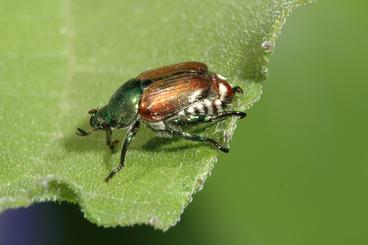
Japanese beetle adults are approximately 3/8 inches in length with a dark metallic green head and metallic dark tan wings. Key characteristics for adult JB are two white rear tufts and five white lateral tufts of hair (Figure 1).
Identifying the grub stage of Japanese beetle
Japanese beetle larvae or grubs are “C” shaped and live in the soil and feed on grass roots. JB was recorded to feed on the roots of corn, beans, tomatoes, and strawberries. Grubs can be identified to species by the pattern of hairs on their brown hind ends (raster). Using a 10-power hand lens, you can see that the hairs on the raster of Japanese beetle form a small “V” shape just below the anal slit (Figure 2).
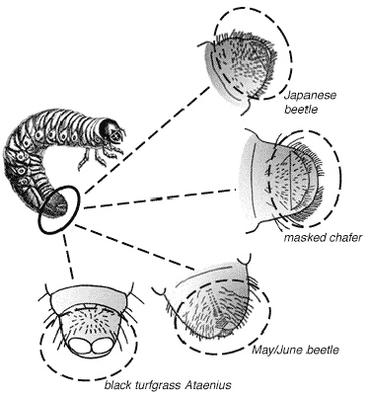
Scouting for grubs
Grubs chew off grass roots and reduce the ability of grass to take up enough water to withstand stresses of hot, dry weather. As a result, large dead patches of grass develop in grub infested areas. These dead patches can be rolled back like a carpet to expose the lack of turf roots. Grubs can be found in adjacent green areas. Early recognition of the problem can prevent this destruction. Starlings and crows, as well as moles, shrews, and skunks may be seen digging up grubs, also damaging the turf.
Grub populations between 7 and 15 per square foot can cause significant damage to non-irrigated turf. Irrigated turf can withstand a higher grub count because the increase in water compensates for the roots chewed off by the grub.
Japanese beetle life cycle
Adults emerge from the soil in early July, feed, mate, and lay eggs. In July adults are noticed feeding on vines, linden trees, roses, and many other ornamentals. Activity is most intense over a 6 to 8 week period, after which the beetles gradually die off. Individual beetles live about 60 days. Over 2 months females can lay a total of 60 eggs.
JB adults feed in full sun at the top of plants, moving downward as the leaves are consumed. Odors emitted from beetle-damaged leaves causes beetles to aggregate. Also, adults release an attraction pheromone that causes them to aggregate. At dusk, this pheromone is no longer produced and the females fly to turf to lay eggs. Females burrow 2 to 3 inches into the soil and lay their eggs. The grubs grow quickly and by late September are almost full-sized (about 1 inch long). When the soil cools to about 60°F in the fall, the grubs begin to move deeper. Most pass the winter 2 to 6 inches below the surface, although some may go as deep as 8 to 10 inches. Grubs feed again in May when ground temperatures are above 50°F (Figure 3).
Timing pesticide application
Adults fly long distances to food plants; so adult infestations do not indicate turf infestations. Timing of pesticide treatment is important. Insecticides for grubs can be applied from May through mid-June, when recently overwintered grubs (larvae) start feeding. However, these grubs are large and may be difficult to kill. Starting in mid- June most grubs are in the pupal stage and insecticides are not effective. In early July adults emerge to feed on plants, mate, and then at night fly to grass to lay eggs. The best time to apply insecticides for grubs is from mid-July until early September. Granular applied insecticides distributed on soil with a spreader are usually the best insecticides for JB (Figure 3).
Insecticide recommendations for grub control
If many adults are feeding on leaves in an area, it does not indicate a grub infestation in the turf. Before applying an insecticide for grubs, make sure you have a large infestation. Look for areas of brown turf and search in adjacent green areas for grubs and pupae. Insecticides are needed to control grubs and adults if the damage is extensive. Irrigating after applying an insecticide improves its insect control. However, a significant rainfall shortly after the application may reduce the insecticide's concentration below effective levels. Infestations should be checked one week after an insecticide is applied, especially if the original grub population was high. If after 10 days the grubs are still alive, apply a different product. Also, read the label carefully for cautions about their use (Tables 1 and 2).
The best time to apply insecticides for grubs is from mid-July until end of September. Granular applied insecticides distributed on soil with a spreader are usually the best insecticides for JB. There are conventional insecticides that kill grubs (imidacloprid) and biorational insecticides that conserve beneficial insects in turf (halofenozide and Acelepryn). In trials in Ohio milky spore disease (Bacillus popillae) has not been as successful in killing JB grubs as was reported in the 1960's. A beneficial nematode, Heterorhabditis bacteriophora, attacks JB grubs. Nematodes are microscopic parasitic roundworms that transport and feed on bacteria. When they find a grub, the nematodes penetrate the larva and inoculate it with bacteria, which quickly multiply within the grub's body. The nematode then feeds on the bacteria. Nematodes need to be applied to soil at night and the soil must be irrigated daily to kill it moist so the nematodes stay alive.
Insecticide recommendations for adult control
Removing beetles by hand may provide adequate protection for backyards, especially when beetle numbers are low. The presence of beetles on a plant attracts more beetles. Thus, by not allowing beetles to accumulate, plants will be less attractive to other beetles. One of the easiest ways to remove Japanese beetles from small plants is to shake them off into jars filled with soapy water.
With all insecticidal products, foliage and flowers should be thoroughly treated. The application may need to be repeated to prevent reinfestation. Follow label directions and avoid spraying under windy conditions. Never spray when bees are foraging. Be sure the insecticide is registered for use on the plant or crop you intend to spray. If it is a food crop, note the minimum number of days that must be observed between the date of the last application and the date of harvest.
Different chemicals are used on adults when feeding on foliage. Foliar sprays of chlorantraniliprole are effective against adults and has low toxicity to bees. Foliar sprays of contact insecticides kill adults and offer immediate knockdown, such as carbaryl, acephate, pyrethrins, and pyrethroids. Examples include pyrethroid products such as cyfluthrin (Tempo, Bayer Advanced Lawn & Garden Multi-Insect Killer), bifenthrin (TalstarOne, Onyx), deltamethrin (Deltagard), lambda cyhalothrin (Scimitar, Spectracide Triazicide), esfenvalerate (Ortho Bug-B-Gon Garden & Landscape Insect Killer) and permethrin (Spectracide Bug Stop Multi-Purpose Insect Control Concentrate and other brands). Both pyrethroids and carbaryl provide around 2 weeks of protection. For adults, repeated applications may be necessary because of the relatively short residual effect of the pesticides. Insecticides that are advertised as organic usually do not kill adults. Formulations with pyrethrins and PBO (piponeryl butoxide) are more effective. Neem products such as Azatrol may provide about 3-4 days deterrence of feeding. Insecticidal soap, extracts of garlic, hot pepper, or orange peels, and companion planting, are generally ineffective (Tables 1 and 2).
Soil-applied chlorantraniliprole is effective against grubs and has low toxicity to bees. Soil-applied imidacloprid is systemic and translocated around the plant and kills adults when feeding on foliage. However, when adults feed on petals of shrub roses rather than the spiny leaves, imidacloprid is not effective. Soil-applied imidacloprid used on linden or basswood trees or any plant visited by bees or beneficial insects, can potentially kill any bees or beneficial insects feeding on the pollen and nectar in the flowers.
JB traps: are they useful in controlling JB adults?
Pheromone traps contain a lure with the scent of geraniums and rose (geraniol) and the sex pheromone of the JB female. The pheromone is very powerful and will call in beetles from a few thousand feet. Research demonstrated that more beetles fly toward traps then are caught; resulting in surplus beetles that feed on your plants. Think twice before purchasing and installing a pheromone trap. Some growers have set pheromone traps over basins filled with soapy water with a white bottom (opaque white plastic bag) to increase the size of the area to catch beetles. Some testify that these pools fill with beetles that drown in the soap and reduce the numbers in the area. If you are really frustrated with JB numbers, please try this method and see if JB numbers on your plants are reduced.
| Table 1. Insecticides to control Japanese beetle grubs and adults. Use for grubs when damage is observed. Use for adults when feeding and damage is observed on ornamentals. If a product does not work, switch to a different insecticide. a) Insecticides to control Japanese beetle grubs: incomplete list of professional and homeowner products. |
| Common Name | Trade Name | Target | Class | Comments |
|---|---|---|---|---|
|
imidacloprid |
Merit, Menards Grub Control |
grubs |
neonicotinyl |
Low toxicity to mammals. |
|
clothianidin |
Arena |
grubs |
neonciotinyl |
Low toxicity to mammals. |
|
chlorantraniliprole |
GrubEx, Acelepryn |
grubs |
diamide |
Conserves adult predators and bees. Environmentally friendly. Available to professional applicators. |
|
trichlorfon |
Dylox |
grubs |
organophosphate |
High toxicity to birds, fish. Do not use within 100 yards of water. Available for homeowner use. Not effective in pH 8 water. |
|
Bacillus thuringiensis galleriae |
grubGONE!G |
grubs |
bacteria |
Better than Milky spore, Japademic Doom, not effective |
|
Heterorhabditis bacteriophora |
|
grubs |
nematodes |
Water before and daily after application. |
b) Insecticides to control Japanese beetle adults: incomplete list of professional and homeowner products
|
Common name |
Trade name |
Target |
Class |
Comments |
|
carbaryl |
Sevin |
adults |
carbamate |
High toxicity to bees, earthworms; moderately toxic to birds, fish. Do not use adjacent to water. Available for homeowner use. |
|
bifenthrin |
Talstar, Menards Insect Control, (many other names) |
adults |
pyrethroid |
High toxicity to honeybees, birds, fish. Do not use within 100 yards of water. |
|
cyfluthrin |
Tempo, Bayer Advanced Lawn & Garden Multi-Insect Killer |
adults |
pyrethroid |
High toxicity to birds, fish. Do not use adjacent to water. |
|
lambda- cyhalothrin |
Scimitar, Spectracide, Triazicide |
adults |
pyrethroid |
High toxicity to fish. |
|
permethrin |
Astro, Spectracide Bug Stop Multi- Purpose Insect Control Concentrate |
adults |
pyrethroid |
High toxicity to fish, bees. For home lawns only. |
|
esfenvalerate |
Ortho Bug-B-Gon Garden & Landscape Insect Killer |
adults |
pyrethroid |
High toxicity to honeybees. Odor may be a problem in public places. |
|
deltamethrin |
DeltaGard |
adults |
pyrethroid |
High toxicity to birds, fish. Do not use adjacent to water. |
|
chlorantranili prole |
Acelepryn |
adults |
diamide |
Conserves bees, predators |
| pryrethrins+PBO (piperonly butoxide) | Pyganic | pyrethrins or alone less effective; | ||
Table 2. For nurseries, insecticides (professional) to add to soil media to control JB grubs.
|
Common name |
Trade name |
Class |
Comment |
|---|---|---|---|
|
bifenthrin |
Talstar |
pyrethroid |
For use in containers. |
|
imidacloprid |
Marathon |
chloronicotinyl |
For use in containers. |
Cultural control
Carefully select plant species that Japanese beetle adults do not like to feed on, when retrofitting or adding to your landscape or golf course. Certain common landscape plants are inevitably attacked and may be poor landscape choices (Table 3). The nursery industry can reduce Japanese beetle numbers in cultivated areas or containers by eliminating grasses that the grubs feed upon.
Table 3. Preferred plants of Japanese beetle.
| a) Plants that attract beetles |
|---|
|
American chestnut |
apple |
grapes |
plum |
|
American elm |
birch |
hollyhock |
roses |
|
American linden |
black cherry |
horse chestnut |
walnut |
|
American mountain ash |
flowering crabapple |
Norway Maple |
|
| b) Plants seldom damaged |
|---|
|
American elder |
euomymus |
holly |
red oak |
spruce |
|
arborviate |
fir |
juniper |
rhododendron |
white ash |
|
black oak |
green ash |
pine |
scarlet oak |
white oak |
|
boxelder |
hemlock |
red maple |
silver maple |
white poplar |
|
common lilac |
|
|
|
|
Biological control
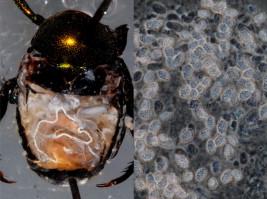
The spraying of insecticides on bee lawns for JB grubs and on leaves and flowers for JB adults, probably results in the most insecticide used in urban and park lands, which may have non-targeted consequences for pollinators. Fortunately, JB has a natural biocontrol agent that was discovered in 1988 in Connecticut that kills JB grubs and reduces reproduction in adult females that needs to be introduced into MN. The microsporidian (fungal) pathogen called Ovavesicula popilliae was studied at Michigan State University (MSU) and released in five states, Arkansas, Colorado, Kansas, Kentucky, and Michigan. For the long term, research is needed to survey greater MN for the presence of JB and the pathogen, which so far was found in two locations in Stillwater and UM Experiment Station Campus in Saint Paul. MN. Research is underway to identify, culture, and disseminate the biocontrol pathogen. For the short term, integrated pest management (IPM) programs using pollinator friendly chlorantraniliprole and microbial insecticides need to be developed that conserve pollinators and kill JB. However, recent research showed that chlorantraniliprole is highly toxic to larval and adult butterflies.
Although released by the MDA in the 1990's, the tachinid fly Istocheta aldrichi that parasitizes adults, and a wasp Tiphia vernalis that parasitizes overwintering grubs, did not cause much JB mortality and were not widely established.
The MN Department of Agriculture and the MN Department of Natural Resources list Japanese beetle (JB, Popillia japonica) as a highly destructive, invasive exotic pest (USDA 2017, CAB 2005). Since introduced from Japan in 1916, JB defoliates over 300 plant species, including, linden trees, basswood trees, apples, corn, and soybean. Adult beetles can aggregate on leaves and fruits and feed in large numbers, that renders the fruit unmarketable. In addition, the immature grub stage feeds on the roots of grasses in pastures, green space, and recreational turf. Japanese beetle damages owers, fruits, and foliage which results in fewer owers and less food for bees, as well as less fruits for wildlife. However, the spraying of insecticides on bee lawns for JB grubs and on plants and owers for adults, probably results in the more pollinator deaths. Fortunately, JB has a natural biocontrol agent that was discovered in 1988 in Connecticut killing JB grubs (Hanula and Andreadis 1988) that needs to be introduced into MN. The microsporidian (fungal) pathogen called Ovavesicula popilliae was studied at Michigan State University (MSU) (Perry et al. 2013, Smitley 2011) and released in four states. MSU identied the pathogen in MN JB. For the long term, research is needed to survey greater MN for the presence of JB and the pathogen, which so far was found in one location in MN. For the short term, IPM programs need to be developed that conserve pollinators and manage JB.The purpose of this research is to develop new management tactics to reduce economic and environmental damage caused by the exotic JB. The outcome is to reduce JB numbers locally and to slow its spread around the state of MN.
